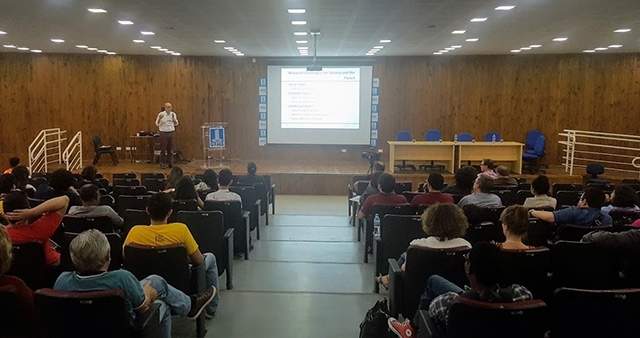

Guaranteeing stable funding is key if Brazilian researchers are to use the scientific instruments that will become available in the years ahead, according to experts at the Annual Meeting of the Brazilian Society for the Advancement of Science (photo: Elton Alisson / Agência FAPESP)
Guaranteeing stable funding is key if Brazilian researchers are to use the scientific instruments that will become available in the years ahead, according to experts at the Annual Meeting of the Brazilian Society for the Advancement of Science.
Guaranteeing stable funding is key if Brazilian researchers are to use the scientific instruments that will become available in the years ahead, according to experts at the Annual Meeting of the Brazilian Society for the Advancement of Science.

Guaranteeing stable funding is key if Brazilian researchers are to use the scientific instruments that will become available in the years ahead, according to experts at the Annual Meeting of the Brazilian Society for the Advancement of Science (photo: Elton Alisson / Agência FAPESP)
By Elton Alisson in Campo Grande (Brazil) | Agência FAPESP – Three of the most significant recent scientific breakthroughs – the detection of the Higgs boson in 2012, the first direct observation of gravitational waves in 2015, and the first image of a black hole in 2019 – have one thing in common: they all resulted from major collaborative projects involving researchers in several countries, including Brazil.
This kind of international cooperation is set to become more frequent in the years ahead, as a number of mega-telescopes and large research facilities begin operating in different parts of the world.
If the Brazilian scientific community is to contribute effectively to projects such as these, it will need stable sources of funding, according to the participants in a round table on major cooperation projects held on July 23, 2019, during the 71st Annual Meeting of the Brazilian Society for the Advancement of Science (SBPC).
“It’s hard for us to sign agreements to participate in these large-scale international scientific collaborations because of the lack of stability in funding for the experiments,” said João Ramos Torres de Mello Neto, Full Professor at the Federal University of Rio de Janeiro (UFRJ) and a speaker at the event, which took place on July 21-27 in Campo Grande, Mato Grosso do Sul. The theme of this year’s meeting was “Science and innovation at the frontiers of the bioeconomy, diversity and social development”.
“In the long run, the Brazilian scientific community’s participation in these large-scale international collaborations has been based strongly on the projects of individual researchers or small groups, and most of the funding is short-term,” Mello said.
To change this situation, he went on, Brazilian participation in international collaborations must be funded as a matter of state policy involving not just agencies subordinated to the Ministry of Science, Technology, Innovation and Communications (MCTIC) but also the Ministries of the Economy and of Industry and Foreign Trade. This is because Brazil’s participation in such projects is strategic for all these sectors.
“Brazilian involvement in these major scientific projects would yield high returns, extending knowledge, developing human capital and enabling our companies to acquire or develop new technology,” Mello said.
Given that these projects set out to answer questions on the knowledge frontier, they require the development of new technology, mostly by researchers who collaborate with companies, explained Reinaldo Ramos de Carvalho, a professor at Cruzeiro do Sul University (UNICSUL) in São Paulo.
As an example, he mentioned the charge-coupled device (CCD) image capture sensors used in digital cameras and smartphones. CCDs were invented in the late 1960s for use in astronomy. As sensitive detectors of photons, they are ideal substitutes for film or photographic plates in telescopes.
“Synergy between science and technology is imperative in these large-scale international collaborations, which therefore need participation by the private sector,” Carvalho said.
Project leadership
The creation of opportunities to develop technology for industry in São Paulo State is one of the criteria FAPESP takes into consideration in analyzing proposals to participate in large international collaborative projects, according to Roberto Marcondes Cesar Junior, Full Professor at the University of São Paulo (USP) and a member of FAPESP’s Adjunct Panel for Physics, Mathematics, Chemistry and Engineering.
Other criteria for approval are project leadership by the researchers who apply for funding and their involvement in the development of scientific instrumentation for the projects.
“FAPESP believes the researchers it supports should be going after more than the scientific research they’ll perform in these large international collaborations,” Marcondes Cesar said. “They should strive to be leaders and protagonists and, whenever possible, to get involved with instrumentation and the creation of technological development opportunities for industry in São Paulo State.”
For example, he went on, researchers at USP’s Engineering School (POLI-USP) are project leaders in this sense. In a project supported by FAPESP, they designed and developed a chip called SAMPA for installation in the detection system to be used by ALICE (A Large Ion Collider Experiment), one of four major experiments at CERN’s Large Hadron Collider (LHC).
Additionally, with FAPESP’s support, researchers at the University of Campinas (UNICAMP) have developed a light detector called ARAPUCA for use in the Deep Underground Neutrino Experiment (DUNE).
DUNE is an international science collaboration that seeks to discover new properties of neutrinos, elementary particles with very little mass that travel at near light speed.
“These are all high-level Brazilian projects to develop scientific instruments, and they’re doing very well,” Marcondes Cesar said.
Republish
The Agency FAPESP licenses news via Creative Commons (CC-BY-NC-ND) so that they can be republished free of charge and in a simple way by other digital or printed vehicles. Agência FAPESP must be credited as the source of the content being republished and the name of the reporter (if any) must be attributed. Using the HMTL button below allows compliance with these rules, detailed in Digital Republishing Policy FAPESP.




